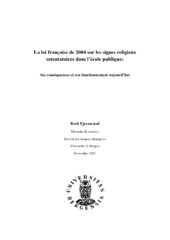La loi francaise de 2004 sur les signes religieux ostentatoires dans l'école publique: Ses conséquences et son fonctionnement aujourd'hui
Master thesis
Permanent lenke
https://hdl.handle.net/1956/7334Utgivelsesdato
2011-11-22Metadata
Vis full innførselSamlinger
Sammendrag
This thesis treats the consequences of the French law that was passed in 2004, stating that all religious and ostentatious signs in public schools are illegal. In order to make the consequences of this law clear, I have been interviewing teachers, headmasters and students in schools in Paris and its surrounding suburban areas. This is not a quantitative study, but rather a qualitative research. Because there are a limited number of interviewees, it is important to emphasize that this study does not propose to give an extensive answer as of the consequences of this law, but simply an insight into possible consequences of the 2004 law. I noticed quite early on that a great proportion of the interviewees were positive to this law. They explained that before 2004, when there was no precise law, it was difficult for a teacher for example to ask a student to take off her hijab during the gym class. A lot of the interviewees also explained that after the law was passed, the tensions at school between different religious groups ceased and therefore also calmed down". The main arguments in favour of this law were the laïcité" principle (secularism principle) and gender equality. Over the course this study I have noticed that the laïcité" is a complex principle that initially treated specifically the separation of church and state, but as time has gone by, has integrated values like equality of religion, freedom of speech and some might also say integration. One of the arguments in favour of the law is that because the public school is a state run establishment, it is also neutral concerning all religions. If the students are allowed to wear religious ostentatious signs at school, like a veil or a turban, this breaks with the laïcité" principle of a neutral, non-religious school. When it comes to the question of gender equality, a great part of the interviewees were of the opinion that there is no equality between the sexes if a girl has to wear a hijab at school. They also thought that the veil in itself is a sign of oppression. Because of this argument, many of the supporters of the law thought that the law was necessary because it could be conductive in helping Muslim girls that wore a veil out of oppression. The present study has shown that there are many different interpretations of the notions around this law. The laïcité" principle is not understood the same way, nor is the gender equality principle. I noticed for example that among the interviewees, the word ostentatious" is not defined the same way. I saw that these definition problems lead to different interpretations of the law on the different schools. This thesis treats the consequences of the French law that was passed in 2004, stating that all religious and ostentatious signs in public schools are illegal. In order to make the consequences of this law clear, I have been interviewing teachers, headmasters and students in schools in Paris and its surrounding suburban areas. This is not a quantitative study, but rather a qualitative research. Because there are a limited number of interviewees, it is important to emphasize that this study does not propose to give an extensive answer as of the consequences of this law, but simply an insight into possible consequences of the 2004 law. I noticed quite early on that a great proportion of the interviewees were positive to this law. They explained that before 2004, when there was no precise law, it was difficult for a teacher for example to ask a student to take off her hijab during the gym class. A lot of the interviewees also explained that after the law was passed, the tensions at school between different religious groups ceased and therefore also calmed down". The main arguments in favour of this law were the laïcité" principle (secularism principle) and gender equality. Over the course this study I have noticed that the laïcité" is a complex principle that initially treated specifically the separation of church and state, but as time has gone by, has integrated values like equality of religion, freedom of speech and some might also say integration. One of the arguments in favour of the law is that because the public school is a state run establishment, it is also neutral concerning all religions. If the students are allowed to wear religious ostentatious signs at school, like a veil or a turban, this breaks with the laïcité" principle of a neutral, non-religious school. When it comes to the question of gender equality, a great part of the interviewees were of the opinion that there is no equality between the sexes if a girl has to wear a hijab at school. They also thought that the veil in itself is a sign of oppression. Because of this argument, many of the supporters of the law thought that the law was necessary because it could be conductive in helping Muslim girls that wore a veil out of oppression. The present study has shown that there are many different interpretations of the notions around this law. The laïcité" principle is not understood the same way, nor is the gender equality principle. I noticed for example that among the interviewees, the word ostentatious" is not defined the same way. I saw that these definition problems lead to different interpretations of the law on the different schools.
